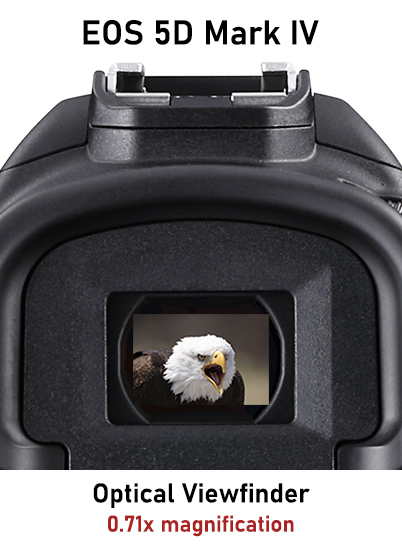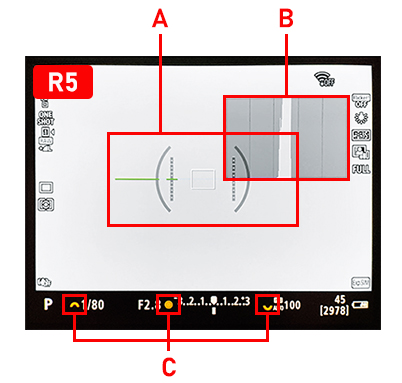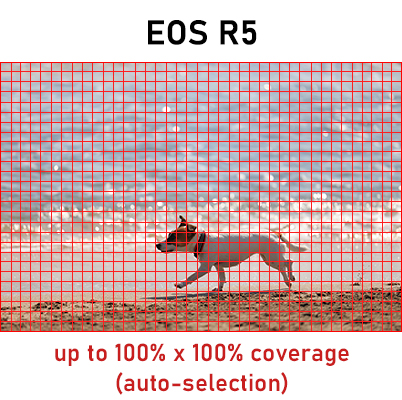9 Reasons to Switch to EOS R5 from EOS 5D Mark IV
Equipped with not only dual card slots, but also tremendous improvements to AF performance and imaging prowess, the EOS R5 is an all-rounder that combines the reliability of the much-beloved EOS 5D series cameras with advanced mirrorless camera technologies. An all-metal body with weather sealing equivalent to the EOS 5D Mark IV provide further reassurance on durability, making it an irresistible upgrade. (Reported by: Kazuo Nakahara, Digital Camera Magazine)

1. Better resolution
More than just the megapixels


With the EOS R5, not only do you get more megapixels than the EOS 5D Mark IV, you can also enjoy the benefits of RF lenses, which are designed for better optical performance. The combination of RF lenses, the new DIGIC X image processing engine, and the EOS R5’s image sensor unlocks the highest imaging power to date on an EOS camera. Real-time lens aberration correction via the Digital Lens Optimizer is also faster than ever.

These buildings have densely concentrated lines—perfect for testing resolution. I captured them at f/8 from slightly further back and compared the details in the captured images. Digital Lens Optimizer was enabled.
Gear used:
EOS 5D Mark IV + EF24-70mm f/2.8L II USM
EOS R5 + RF24-70mm f/2.8L IS USM
A: Centre
EOS 5D Mark IV

EOS R5

B: Corner
EOS 5D Mark IV

EOS R5

2. The high-definition, convenient EVF
More information, better visualisation


The EOS R5 has a high definition 5.76 million dot electronic viewfinder (EVF) with a 0.76x magnification, which means that the viewfinder image is 0.76 times the actual image seen by the naked eye. This is slightly larger than the 0.71x magnification offered by the optical viewfinder (OVF) on the EOS 5D Mark IV. With a display frame rate of up to 120 fps, the EOS R5’s EVF offers a view nearly as seamless as an OVF.
The EVF display stays sufficiently bright even in low light, and doesn’t darken even when you press the depth of field preview button. It also lets you review images even when outdoors in bright sunlight. Support for tools like the Focus Guide and MF peaking makes manual focusing easier than ever.


A: Electronic level
B: Histogram
C: Dial icons
An EVF lets you display more information than an OVF, such as the histogram, electronic level, and other shoot details. The dial icons provide a visual guide that makes controlling the camera more intuitive.
3. Wider AF coverage
Face/eye detection and subject tracking over the entire image area


The EOS R5 is equipped with Dual Pixel CMOS AF II, which is able to conduct face detection and subject tracking across approximately 100% x 100% of the image area in Face Detection + Subject Tracking Priority (fully automatic AF) mode. If you prefer to manually select your AF points, you can do so over a relatively wide area covering approximately 100% (vertical) x 90% (horizontal) of the image area, so that you can frame images with even greater flexibility.
The EOS R5 also boasts better subject recognition capabilities thanks to EOS iTR AF X, which is based on deep learning technologies. This makes it capable of detecting the eyes, face, and bodies of dogs, cats, and birds in addition to the eyes, faces, and heads of humans (see point 8). And you will have these capabilities at your disposal over a greater coverage area!
A comparison of AF coverage areas

A: EOS R5 (automatic AF area selection)
B: EOS R5 (manual AF area selection)
C: EOS 5D Mark IV (Live View shooting)
D: EOS 5D Mark IV (Viewfinder shooting)
As the diagram above shows, the difference in AF coverage between the EOS R5 and EOS 5D Mark IV is quite significant especially during viewfinder shooting.
4. Support for faster memory cards
Seamless continuous shooting, speedier file transfers


*Illustrations are not drawn to scale
Both types of memory card used on the EOS R5 (CFexpress Type B and UHS-II SD) support writing speeds significantly faster than the CF (UDMA7) card supported by the EOS 5D Mark IV. In fact, the writing speeds possible on CFexpress cards are on a whole new level—you no longer need to wait for the buffer to clear. Reading speeds are much faster too, which means you can look forward to quicker file transfers from memory card to computer.

5. The fully articulating Vari-angle rear monitor
Different angles to unleash your creativity


With mirrorless cameras, you are likely to shoot more with the rear LCD screen, and a fully articulating Vari-angle monitor is perfect for the job. The one on the EOS R5 lets you freely and comfortably explore different camera positions and angles, especially when combined with the Touch Shutter. This is further supported by the In-Body Image Stabilizer (In-Body IS), which offers up to eight stops’ image stabilisation for easier handheld shooting (see point 6).
Learn more about how features like the Vari-angle monitor on the EOS R5 revolutionised one photography’s shooting style in:
Why the EOS R5 is My Ideal Camera for Landscape Photography
6. In-Body IS
Increased handheld shooting possibilities


The EOS R5, along with the EOS R6, is the first EOS camera to feature a five-axis In-Body Image Stabilizer (In-Body IS). When a compatible lens equipped with Optical IS (lens-based IS) is attached, the two image stabilisation systems work in tandem to perform Coordinated Control IS, which can achieve as much as eight shutter speed stops’ image stabilisation.
Learn more about 3 Types of Scenes That Take Full Advantage of In-Body IS
7. 8 AF methods to choose from
Further customisation for your subject’s movement patterns



The EOS R5 has more Zone AF method options than the EOS 5D Mark IV, providing even more flexibility to choose the AF method that best suits your subject. AF accuracy and support for Servo AF also surpasses that of the EOS 5D Mark IV.
8. Dramatic improvements to Face Detection + Subject Tracking AF
A new deep-learning based AF algorithm that realises new possibilities


While the EOS 5D Mark IV was capable of detecting human face detection, the EOS R5 detects not just human eyes, heads, and faces but also the eyes, faces, and bodies of cats, dogs and birds. The improvement is partly due to the incorporation of EOS iTR AF X, a new AF algorithm based on deep learning, resulting in a leap in the camera’s human and animal detection capabilities.
EOS R5 + RF100-500mm f/4-7.1 IS USM @ FL: 451mm, f/7.1, 1/3200 sec, ISO 1600
The significant improvements to AF performance and coverage make it easier to capture fast-moving subjects such as birds in flight.
Also see:
3 Types of Dog Portraits to Capture with Animal Detection AF
Birds in Flight: Camera Settings to Increase Your Successful Shots
9. AF even at maximum aperture f/22
Expanded compatibility with extenders
The AF sensor of the EOS 5D Mark IV supported focusing up to maximum aperture f/8, which was just right for using Canon’s fast super telephoto prime lenses with an extender. On the EOS R5, AF is supported on lenses up to maximum aperture f/22. This means compatibility with a greater range of lens-extender pairings, such as the affordable RF800mm f/11 IS STM paired with the Extender RF 2x.
Also considering the EOS R6? This article might make the decision easier:
EOS R5 vs EOS R6: 5 Key Differences to Note
Receive the latest update on photography news, tips and tricks.
Be part of the SNAPSHOT Community.
Sign Up Now!About the Author
A monthly magazine that believes that enjoyment of photography will increase the more one learns about camera functions. It delivers news on the latest cameras and features and regularly introduces various photography techniques.
Published by Impress Corporation
Born in Hokkaido in 1982, Nakahara turned to photography after working at a chemical manufacturing company. He majored in photography at the Vantan Design Institute and is a lecturer for photography workshops and seminars, in addition to working in commercial photography. He is also a representative of the photography information website studio9.


































.jpg)


